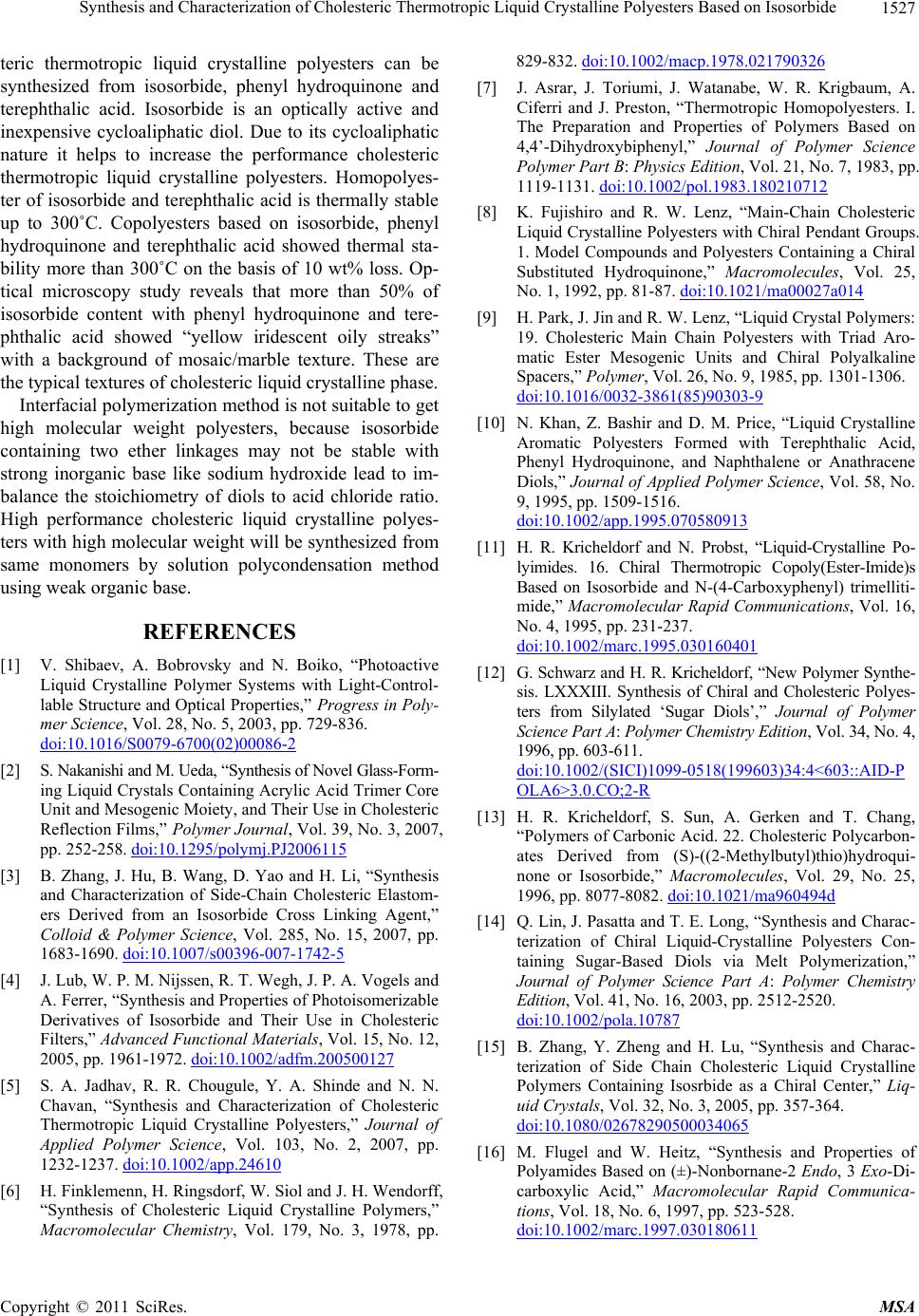
Synthesis and Characterization of Cholesteric Thermotropic Liquid Crystalline Polyesters Based on Isosorbide
Copyright © 2011 SciRes. MSA
1527
teric thermotropic liquid crystalline polyesters can be
synthesized from isosorbide, phenyl hydroquinone and
terephthalic acid. Isosorbide is an optically active and
inexpensive cycloaliphatic diol. Due to its cycloaliphatic
nature it helps to increase the performance cholesteric
thermotropic liquid crystalline polyesters. Homopolyes-
ter of isosorbide and terephthalic acid is thermally stable
up to 300˚C. Copolyesters based on isosorbide, phenyl
hydroquinone and terephthalic acid showed thermal sta-
bility more than 300˚C on the basis of 10 wt% loss. Op-
tical microscopy study reveals that more than 50% of
isosorbide content with phenyl hydroquinone and tere-
phthalic acid showed “yellow iridescent oily streaks”
with a background of mosaic/marble texture. These are
the typical textures of cholesteric liquid crystalline phase.
Interfacial polymerization method is not suitable to get
high molecular weight polyesters, because isosorbide
containing two ether linkages may not be stable with
strong inorganic base like sodium hydroxide lead to im-
balance the stoichiometry of diols to acid chloride ratio.
High performance cholesteric liquid crystalline polyes-
ters with high molecular weight will be synthesized from
same monomers by solution polycondensation method
using weak organic base.
REFERENCES
[1] V. Shibaev, A. Bobrovsky and N. Boiko, “Photoactive
Liquid Crystalline Polymer Systems with Light-Control-
lable Structure and Optical Properties,” Progress in Poly-
mer Science, Vol. 28, No. 5, 2003, pp. 729-836.
doi:10.1016/S0079-6700(02)00086-2
[2] S. Nakanishi and M. Ueda, “Synthesis of Novel Glass-Form-
ing Liquid Crystals Containing Acrylic Acid Trimer Core
Unit and Mesogenic Moiety, and Their Use in Cholesteric
Reflection Films,” Polymer Journal, Vol. 39, No. 3, 2007,
pp. 252-258. doi:10.1295/polymj.PJ2006115
[3] B. Zhang, J. Hu, B. Wang, D. Yao and H. Li, “Synthesis
and Characterization of Side-Chain Cholesteric Elastom-
ers Derived from an Isosorbide Cross Linking Agent,”
Colloid & Polymer Science, Vol. 285, No. 15, 2007, pp.
1683-1690. doi:10.1007/s00396-007-1742-5
[4] J. Lub, W. P. M. Nijssen, R. T. Wegh, J. P. A. Vogels and
A. Ferrer, “Synthesis and Properties of Photoisomerizable
Derivatives of Isosorbide and Their Use in Cholesteric
Filters,” Advanced Functional Materials, Vol. 15, No. 12,
2005, pp. 1961-1972. doi:10.1002/adfm.200500127
[5] S. A. Jadhav, R. R. Chougule, Y. A. Shinde and N. N.
Chavan, “Synthesis and Characterization of Cholesteric
Thermotropic Liquid Crystalline Polyesters,” Journal of
Applied Polymer Science, Vol. 103, No. 2, 2007, pp.
1232-1237. doi:10.1002/app.24610
[6] H. Finklemenn, H. Ringsdorf, W. Siol and J. H. Wendorff,
“Synthesis of Cholesteric Liquid Crystalline Polymers,”
Macromolecular Chemistry, Vol. 179, No. 3, 1978, pp.
829-832. doi:10.1002/macp.1978.021790326
[7] J. Asrar, J. Toriumi, J. Watanabe, W. R. Krigbaum, A.
Ciferri and J. Preston, “Thermotropic Homopolyesters. I.
The Preparation and Properties of Polymers Based on
4,4’-Dihydroxybiphenyl,” Journal of Polymer Science
Polymer Part B: Physics Edition, Vol. 21, No. 7, 1983, pp.
1119-1131. doi:10.1002/pol.1983.180210712
[8] K. Fujishiro and R. W. Lenz, “Main-Chain Cholesteric
Liquid Crystalline Polyesters with Chiral Pendant Groups.
1. Model Compounds and Polyesters Containing a Chiral
Substituted Hydroquinone,” Macromolecules, Vol. 25,
No. 1, 1992, pp. 81-87. doi:10.1021/ma00027a014
[9] H. Park, J. Jin and R. W. Lenz, “Liquid Crystal Polymers:
19. Cholesteric Main Chain Polyesters with Triad Aro-
matic Ester Mesogenic Units and Chiral Polyalkaline
Spacers,” Polymer, Vol. 26, No. 9, 1985, pp. 1301-1306.
doi:10.1016/0032-3861(85)90303-9
[10] N. Khan, Z. Bashir and D. M. Price, “Liquid Crystalline
Aromatic Polyesters Formed with Terephthalic Acid,
Phenyl Hydroquinone, and Naphthalene or Anathracene
Diols,” Journal of Applied Polymer Science, Vol. 58, No.
9, 1995, pp. 1509-1516.
doi:10.1002/app.1995.070580913
[11] H. R. Kricheldorf and N. Probst, “Liquid-Crystalline Po-
lyimides. 16. Chiral Thermotropic Copoly(Ester-Imide)s
Based on Isosorbide and N-(4-Carboxyphenyl) trimelliti-
mide,” Macromolecular Rapid Communications, Vol. 16,
No. 4, 1995, pp. 231-237.
doi:10.1002/marc.1995.030160401
[12] G. Schwarz and H. R. Kricheldorf, “New Polymer Synthe-
sis. LXXXIII. Synthesis of Chiral and Cholesteric Polyes-
ters from Silylated ‘Sugar Diols’,” Journal of Polymer
Science Part A: Polymer Chemistry Edition, Vol. 34, No. 4,
1996, pp. 603-611.
doi:10.1002/(SICI)1099-0518(199603)34:4<603::AID-P
OLA6>3.0.CO;2-R
[13] H. R. Kricheldorf, S. Sun, A. Gerken and T. Chang,
“Polymers of Carbonic Acid. 22. Cholesteric Polycarbon-
ates Derived from (S)-((2-Methylbutyl)thio)hydroqui-
none or Isosorbide,” Macromolecules, Vol. 29, No. 25,
1996, pp. 8077-8082. doi:10.1021/ma960494d
[14] Q. Lin, J. Pasatta and T. E. Long, “Synthesis and Charac-
terization of Chiral Liquid-Crystalline Polyesters Con-
taining Sugar-Based Diols via Melt Polymerization,”
Journal of Polymer Science Part A: Polymer Chemistry
Edition, Vol. 41, No. 16, 2003, pp. 2512-2520.
doi:10.1002/pola.10787
[15] B. Zhang, Y. Zheng and H. Lu, “Synthesis and Charac-
terization of Side Chain Cholesteric Liquid Crystalline
Polymers Containing Isosrbide as a Chiral Center,” Liq-
uid Crystals, Vol. 32, No. 3, 2005, pp. 357-364.
doi:10.1080/02678290500034065
[16] M. Flugel and W. Heitz, “Synthesis and Properties of
Polyamides Based on (±)-Nonbornane-2 Endo, 3 Exo-Di-
carboxylic Acid,” Macromolecular Rapid Communica-
tions, Vol. 18, No. 6, 1997, pp. 523-528.
doi:10.1002/marc.1997.030180611